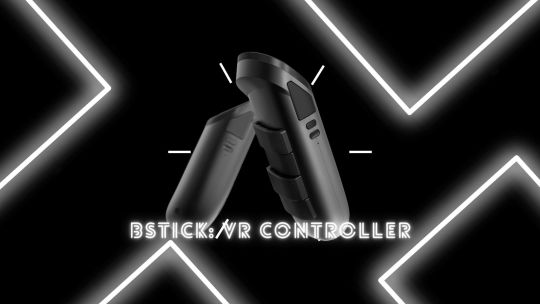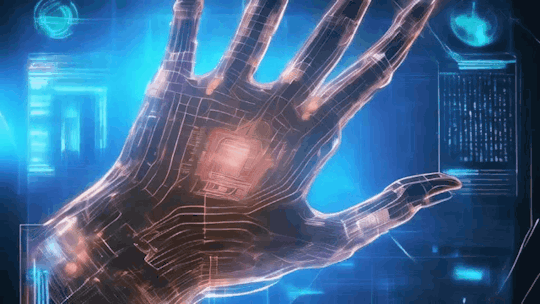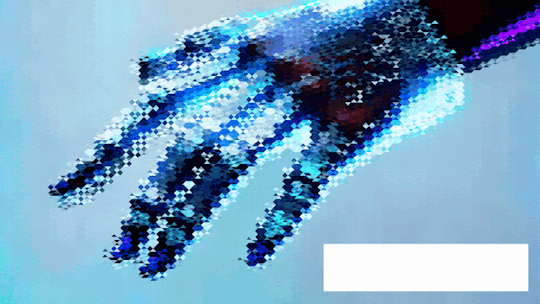#Haptic Technology
Explore tagged Tumblr posts
Text
0 notes
Text
Thanks youse.






A couple of weeks ago, Sonia Allori, Evie Waddell & I completed the practical aspect of my Creative Scotland funded project 'D/deaf musicians experiment with haptic technology' at Tramway, Glasgow.
We were joined remotely by our incredible captioners Eluned Charnley & Karen Pritchard, and in the flesh by tech wizard David Jay, camera cleverclogs Jen Martin, PhD student Henry Zhang and the unstoppable Don Ross.
I reckon that the residency was a success and that it provided us with concrete answers, food for thought & much enjoyment.
In January, I'll get stuck into the mildly daunting task of writing about the various discoveries that we made, but it must be said that this feels like just the beginning of our adventures with haptic tech and the possibilities that it has for D/deaf & HoH improvisers!
Many thanks to my numerous collaborators, and to Creative Scotland & Tramway for their support.
Photos 1, 4 & 5 by myself. Photos 2, 3 & 4 by Jen Martin.
#Ali Robertson#Experimental Music#Free Improv#Free Improvisation#New Music#Noise#Noises#Avant#Electroacoustic#Deaf#deaf#D/deaf#HoH#Hard of Hearing#ALSN#Neurodivergent#Haptics#Haptic Technology#Sonia Allori#Evie Waddell#Tramway#Glasgow#CreativeScotland#Sonic Bothy#TFEH#Giant Tank#Usurper#Still Cannae Believe That I Got Funded!
0 notes
Text
Haptic Technology Market Type, Dynamics, and Industry Analysis by 2032
Haptic technology, also known as kinesthetic communication or 3D touch, is revolutionizing user interfaces by providing tactile feedback that simulates the sense of touch. This technology enables users to feel virtual objects and interactions through vibrations, forces, or motions, creating a more immersive and intuitive experience. Haptic feedback is employed in various applications, including consumer electronics, virtual reality (VR), augmented reality (AR), and medical devices. By bridging the gap between digital and physical interactions, haptic technology enhances user engagement and accessibility, making digital interactions more natural and effective.
The Haptic Technology Market was Valued at USD 3.44 Billion in 2023 and is now anticipated to grow to USD 6.96 Billion by 2032, displaying a compound annual growth rate (CAGR) 7.26% of during the forecast Period 2024 - 2032.
Future Scope:
The future of haptic technology is marked by rapid advancements aimed at improving the realism and precision of tactile feedback. Innovations in material science and sensor technology are expected to enhance the fidelity of haptic sensations, offering more nuanced and responsive interactions. The integration of haptic technology with emerging fields such as VR and AR will likely drive the development of more immersive and interactive experiences. Additionally, advancements in wearable devices and haptic gloves are anticipated to expand the applications of haptic feedback, enabling new possibilities for training, gaming, and remote communication.
Trends:
Current trends in haptic technology include the development of more advanced and compact haptic actuators that provide finer control and higher precision. There is also a growing focus on integrating haptic feedback with VR and AR systems to enhance user immersion and interaction. The use of haptic technology in consumer electronics, such as smartphones and gaming controllers, continues to evolve, with improved feedback mechanisms and customization options. Furthermore, research into wearable haptic devices and non-contact haptic feedback methods is gaining momentum, opening new avenues for applications and user experiences.
Applications:
Haptic technology finds applications across a broad range of fields. In consumer electronics, it is used in smartphones, tablets, and gaming controllers to provide tactile feedback and improve user interaction. In VR and AR environments, haptic technology enhances immersion by simulating touch and physical sensations. The technology is also utilized in medical training devices, allowing practitioners to practice procedures with realistic feedback. Additionally, haptic technology is employed in automotive interfaces and assistive devices to improve user accessibility and safety.
Solutions and Services:
Solutions related to haptic technology include the design and development of haptic feedback systems for various applications, integration with existing devices, and customization to meet specific user needs. Manufacturers offer support services such as prototyping, testing, and optimization to ensure the effectiveness and reliability of haptic solutions. Additionally, consultancy services are available to assist organizations in implementing and leveraging haptic technology to enhance their products and user experiences.
Key Points:
Provides tactile feedback to simulate the sense of touch in digital interactions.
Enhances user experience in consumer electronics, VR, AR, and medical devices.
Future advancements focus on improving realism, precision, and integration with emerging technologies.
Trends include advanced actuators, integration with VR/AR, and wearable devices.
Applications span smartphones, gaming controllers, medical training, and automotive interfaces.
Solutions include system design, integration, prototyping, and consultancy services.
Read More Details: https://www.snsinsider.com/reports/haptic-technology-market-4239
Contact Us:
Akash Anand — Head of Business Development & Strategy
Email: [email protected]
Phone: +1–415–230–0044 (US) | +91–7798602273 (IND)
#Haptic Technology Market#Haptic Technology#Haptic Technology Market Size#Haptic Technology Market Share#Haptic Technology Market Trends
0 notes
Text
【元宇宙觸覺革命】Meta Quest v60更新揭開沉浸式體驗的新紀元
在當今科技浪潮的推動下,元宇宙的觸覺體驗正經歷一場前所未有的創新變革。近期,Meta公司宣布了一項振奮人心的消息:長期處於實驗階段的Haptics Studio和Haptics SDK將在Meta Quest v60的最新更新中正式對公眾開放。這不僅是一次技術的躍進,更是對未來沉浸式體驗的一次大膽探索。該公司將這些工具的應用範圍從Unity擴展至Unreal引擎,從而增強了其兼容性和開放性。 Meta公司通過這些創新工具,為設計師和開發者提供了一個簡便的途徑,以設計、測試及整合觸覺體驗到虛擬及混合現實應用中。這些工具的加入,使得用戶能夠通過觸感體驗更加真實的互動,如逼真的點擊感、生動的質感和細膩的通知。 在這一革新中,Quest 3控制器配備了TruTouch觸覺技術,這不僅提升了沉浸感的層次,也為創意的擴展提供了新的可能。Haptics…

View On WordPress
#API接口#開發者工具#虛擬現實#虛擬現實開發#虛擬實境#虛擬實境遊戲#虛擬實境新聞#虛擬互動#音效整合#觸覺體驗#高品質觸覺#跨平台兼容#Haptic Technology#Haptics SDK#Haptics Studio#immersive VR experience#META#Meta Quest v60 Update#Meta Quest v60更新#Meta Quest控制器#Quest 3#TruTouch技術#Unity and Unreal Integration#Unity平台#Unreal引擎#Virtual Reality Development#vr#vr game#vr news#vr news today
0 notes
Text

Wearable haptics get thinner: A flexible haptic patch lets you feel the virtual world
As virtual reality (VR) and augmented reality (AR) technologies rapidly evolve, the demand for more immersive, multisensory experiences grows alongside them. Among the key frontiers is tactile feedback—the ability to physically feel the virtual world. While wearable haptic suits equipped with vibrational motors or fluidic actuators have made strides in enhancing realism, delivering precise, diverse, and natural tactile sensations to the skin remains a major challenge. The limitation has largely stemmed from a lack of compact, lightweight, high-performance tactile actuators. That's where our research takes a bold step forward. My colleagues and I have developed a new class of thin, flexible tactile actuators designed to deliver rich, nuanced haptic feedback directly to the skin.
Read more.
#Materials Science#Science#Haptics#Wearable technology#Flexible electronics#Actuators#Elastomers#Dielectric
21 notes
·
View notes
Note

I am same and can be trusted around your technology
DAMN BRO dont send me porn without a warning /j
#i love tearing technology apart. idk how the fuck to put it back together but i made earrings out of my phone’s old haptic touch vibrations#cuz they were my fav part of the iphone6s aside from the headphone jack#my ear holes closed so i can’t wear earrings anymore (plus i got hella allergic to metals??)#but i might tear up my old phone (iphone SE 2020) and make some jewelry with that#letters
8 notes
·
View notes
Text
... haptic suit games for blind people... do those exist..? those would be so cool...
#moderator wormwood#theyd probably suck since haptics arent touch#but screens arent reflected light so it could just be a matter of technology
3 notes
·
View notes
Text
The Metaverse is transforming education by enabling immersive, interactive, and engaging learning experiences. Simulanis, a leader in AR, VR, MR, and Metaverse solutions, is at the forefront of this revolution, developing cutting-edge immersive learning technologies for various industries.
#Metaverse education#VR learning solutions#Simulanis Metaverse#Virtual classrooms#Immersive learning#VR training for students#Augmented reality education#AI in education#Gamification in learning#Industrial training in VR#Virtual reality for schools#Metaverse training simulations#Experiential learning technology#Digital twins in education#Simulanis VR training#AI-powered education#Remote learning with VR#Blockchain in education#Future of e-learning#VR medical training#Augmented reality classrooms#Virtual skills development#Metaverse for corporate training#EdTech Metaverse solutions#Interactive learning environments#VR language learning#Simulanis AR VR solutions#Metaverse-based e-learning#Haptic feedback in education#Next-gen education technology
0 notes
Text
HaptX begins North American shipments of HaptX Gloves G1™, world's most #realistic and #advanced #haptic #technology | #virtualreality #immersive
0 notes
Text
Tasting Pixels: A Brief View on Taste XR
In science fiction, it’s easy to sell someone the concept of a digital world far from our everyday reality. A world where anything is possible, with the only limitations being what the technology can provide. But there are aspects of it that make one question, ponder, and overthink. Take the scene in The Matrix of Smith and Cypher eating at a restaurant. Cypher makes a deal with the virtual devil…

View On WordPress
#Digital Lollipop#Future Interfaces Group#Games#Gustatory Tech#Haptic#Scentee#Taste#Taste Simulator#Technology#TTTV#VR#XR
0 notes
Text
Bstick:重塑虛擬現實互動,掌中的觸感革命
在科技飛速發展的今日,虛擬現實(VR)不再是遙不可及的夢想。隨著Bstick的誕生,我們進一步邁向了真實與虛擬無縫對接的新紀元。這款手持式虛擬現實力回饋控制器,以其獨特的設計和功能,重新定義了我們與數位世界的互動方式。 首先,Bstick的設計極為人性化。它摒棄了現有骨骼外骼手套式產品的不便,讓使用者無需忍受穿戴上的困擾。其簡潔的棒狀設計,不僅便於握持,更提供了傳統產品無法比擬的實在握感和震動體驗。這種設計,基於人體工學元素,將功能性放在首位,呈現出簡單而有效的外觀。 此外,Bstick的多功能性也是其一大亮點。無論是遊戲、醫療、虛擬訓練還是健身,這款產品都能派上用場。其六面不同類型的設計,讓任何人都能輕鬆上手,為各種內容提供更豐富的互動體驗。 更值得一提的是,Bstick在提供娛樂體驗的同時,也極大地促進了虛擬現實在醫療、復健、健康護理以及專業技能訓練等領域的應用。其直觀的棒狀模…

View On WordPress
#Advanced VR Tools#真實觸感體驗#Ergonomic VR Hardware#遊戲科技進步#醫療虛擬訓練#虛擬現實發展#虛擬現實控制器#虛擬實境#虛擬實境遊戲#虛擬實境資訊#虛擬實境新聞#高科技VR硬件#Fitness Virtual Reality#Gaming Tech Innovations#Handheld VR Device#Haptic Feedback Technology#Immersive Technology Solutions#Interactive Gaming Accessories#Interactive VR Systems#Next-Gen VR Devices#Realistic VR Experience#Virtual Reality Controller#Virtual Training Equipment#VR Application Development#VR in Healthcare#vr news#vr news today#VR遊戲配件#VR互動解決方案#健身虛擬實境
0 notes
Text

Electrohydraulic wearable devices create unprecedented haptic sensations
Scientists at the Max Planck Institute for Intelligent Systems have invented compact wearable devices that deliver rich, expressive, and pleasant tactile sensations that go far beyond the buzzing vibrations of today's consumer devices. The team published their findings in Advanced Science. Human skin can feel a wide variety of sensations, such as a gentle squeeze, quick taps, or the thud-thud of a heartbeat. In contrast, phones, game controllers, and watches often output only vibrations to get the user's attention. Unfortunately, this sudden fast shaking feels different from most everyday touch interactions, and it can quickly become annoying. Researchers at MPI-IS in Stuttgart have developed cutaneous electrohydraulic (CUTE) wearable devices to greatly expand the haptic sensations that can be created by future consumer products.
Read more.
17 notes
·
View notes
Text

74 notes
·
View notes
